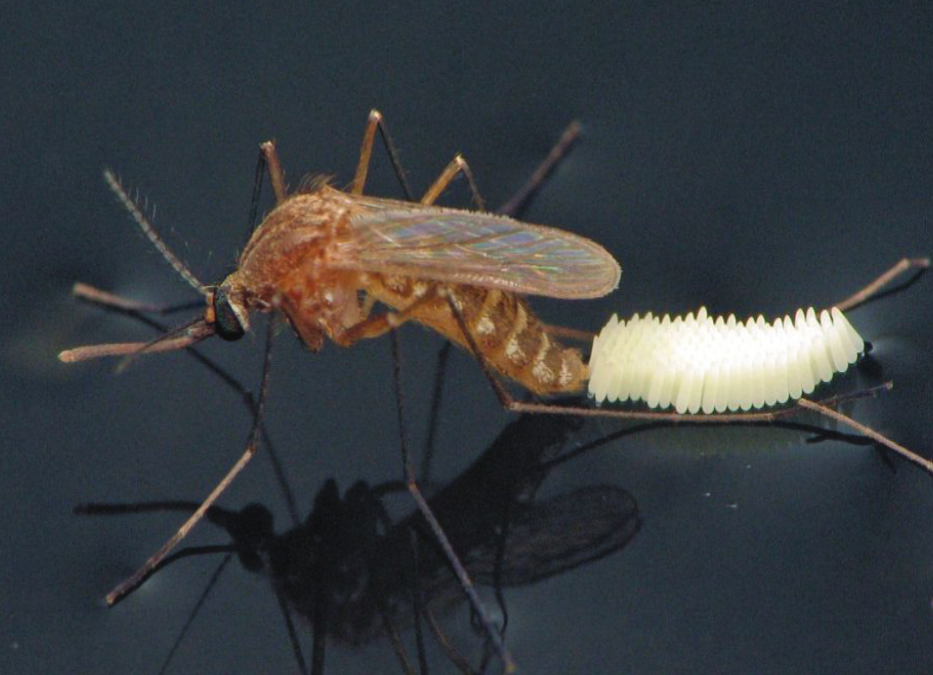
by Ray Bodrey | Jul 15, 2020
Attacking mosquitos are spoilers for our outdoor activity interests this time of year. Hurricanes and other storm events tend to be a catalyst that increases these populations. Not only are mosquitos a nuisance, but they are carriers of several diseases. But, there are ways to control these annoying pests and get some relief.
Mosquito populations can be divided into two categories: floodwater mosquitoes and standing water mosquitoes.
Floodwater mosquitoes need water to lay their eggs, and the eggs also need to dry out before hatching during a storm event. Moist areas like pastures, planting furrows, salt marshes and swales are prime habitat. If you look close, the eggs can be found in cracks in the soil. Again, stormy rains and surge act as a catalyst for these eggs to hatch. So, what is the approximate estimate of mosquito eggs per acre in floodwater habitat in Florida? Scientist estimate 700,000 to 1.3 million eggs per acre. And yes, that’s per acre. Unfortunately, small scale efforts to reduce standing water around properties have little effect on control.
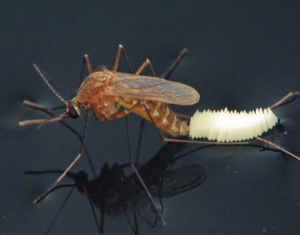
Figure 1. Standing water mosquito and eggs (Culex quinquefasciatus).
Credit: S. McCann, UF/IFAS/FMEL.
On the other side of the coin, standing water mosquitos need,…you guessed it, standing water to lay their eggs. These mosquito eggs cannot withstand drying out, therefore cannot hatch into larva. Females lay eggs on the surface of water with a hatching time of around 24 hours. The larva to pupae to adult stage happens quickly in mosquitoes, and the thirst for blood is not far behind. After a female finds a blood source, the cycle starts all over again. Only the females have biting mouth parts. Both male and female mosquitoes feed on the nectar of flowers. It’s the female mosquitoes that usually need a blood meal to insure mature eggs.The combination of the two groups of mosquitoes provide for a double whammy put in place by a storm. When dry areas flood, floodwater mosquito eggs hatch. When floodwater has nowhere to go, standing water mosquitoes have an abundance of places to lay eggs.
Unfortunately, some diseases can be transmitted by mosquitoes, such as west nile virus, eastern equine encephalitis and even heart worms in dogs. So, what can be done to combat these pests around your property? Reducing the amount of standing water helps dramatically, especially, dumping water holding containers. Cleaning debris from rain gutters too, can help as water can collect in blocked gutters. Mineral or cooking oil can be added to standing water and rain collection devices, as the oil forms a thin film on the surface of the water which causes larvae and pupae to drown. This is also a good control method with plant containers that collect water. Mosquito biological controls, like Bt (Bacillus thuringiensis) are helpful and will not harm pets or livestock. These products can be used in fish habitats, animal water troughs, bird baths, rain barrels, roof gutters and tree holes, just to name some. Please read precautionary statements and manufacturer application directions before use. Rain gardens are also very beneficial in suppressing standing water. If you have an area of your property that is known for water holding capacity, be sure to plant water loving plants in that area.
For more information please contact your local county extension office.
Supporting information for this article can be found in the UF/IFAS EDIS publication: “Hurricanes and Mosquitos” by C. Roxanne Connelly: https://edis.ifas.ufl.edu/pdffiles/IN/IN53500.pdf
UF/IFAS Extension is an Equal Opportunity Institution.
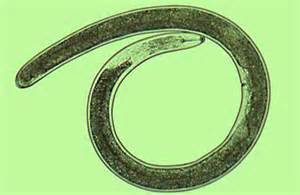
by Rick O'Connor | May 27, 2020
As we continue our series on marine life in the Gulf of Mexico, we also continue our articles on marine worms. Worms are not the most charismatic creatures in the Gulf, but they are very common and play a large role on how life functions in this environment. Roundworms are VERY common. There are at least three phyla of them but here we will focus on one – the nematodes.
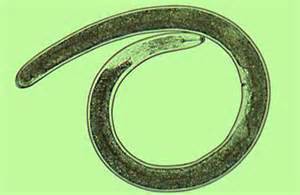
A common nematode.
Photo: University of Florida
Most nematodes are microscopic, a large one would be about 2 inches, and some beach samples have found as many as 2 million worms in 10 ft2 of sand. So, what do we know about them? What role, or function, do they play in the ecology of the Gulf of Mexico?
Well first, they are long and round – cylinder shaped. There is a head end, but it is hard to tell which end is the head. Round is considered a step up from being flat in that it can allow for an internal body cavity. An internal body cavity can allow for the development of internal body organs. Internal body organs can move large amounts of nutrients, blood, oxygen, and hormones around the body allowing the animal to become larger. Some argue that a larger body can have advantages over smaller ones. Some say the opposite, but either way – a large body has been successful for some creatures and an internal body cavity is needed for this.
That said, the nematodes do not have a complete internal body cavity. So, they do not have a complete assortment of internal organs. Being round reduces your efficiency in absorbing enough needed nutrients, oxygen, etc. through your skin alone and this MAY be a reason they are small. They are very small.
There are free living and parasitic forms in this group. There are at least 10,000 species of them, and they can be found not only in the marine environment, but also in freshwater and in the soil found on land. They have played a role in the success of agriculture, infesting both crops and livestock. Nematodes can be a big concern for farmers and gardeners.
The free-living forms are known to be carnivorous, feeding on smaller microscopic creatures. They have toothed lips, and some have a sharp stylet to grab or stab their prey. Some stylets are hollow and can “suck” their prey in. Moving through the environment, they can consume algae, fungi, and diatoms. Some are deposit feeders and others are decomposers. On our farms and in our gardens, they are known to enter plants via the roots and can be found in the fruit.
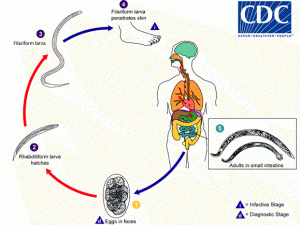
The life cycle of the human hookworm.
Image: CDC
The parasitic version of nematodes has been a problem for some species. In humans we have the hookworms and pinworms. Dogs have their heart worms. An interesting twist on the parasitic nematode way of life, compared to flatworms like tapeworms, is their lack of a secondary (or intermediate host). The entire life cycle can take place in the same animal.
Females are larger than males and fertilizations is internal. Males are usually “hooked” at the tail end and hold on to the females during mating. About 50 eggs will be produced and released into the digestive tract, where they exit the animal in the feces and find new hosts either by the feces being consumed or drifting in the water column.
There multiple forms of parasitism in nematodes.
– Some are ectoparasites (outside of the body) on plants.
– Some are endoparasites in plants – some forming galls on the leaves.
– Some infest animals but only as juveniles.
– Some live-in plants as juveniles and animals as adults.
– Some live-in animals as juveniles and plants as adults.
It would be fair to say that many forms of marine creatures have nematodes living either within them, or on them. Some can be problematic and cause disease; some diseases can be quite serious. Others play an important role in “cleaning” the ocean, filtering the sand of organic debris. Many have heard of nematodes but know little about them. Either good or bad, they do play roles in the ecology of the Gulf of Mexico. 
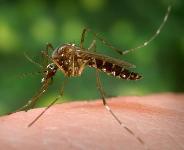
by Rick O'Connor | Mar 24, 2020
Article By: Whitney Cherry
4-H Agent Calhoun County
I know COVID-19 has been driving public and private discussion as of late. But, we have to stay vigilant in working against all public health threats. One of those threats we typically start talking about this time of year is mosquito borne illnesses and preventative mosquito control. Not only are mosquitoes pests, but they can transmit some pretty nasty diseases we wouldn’t want under normal circumstances. But with our healthcare system currently inundated with COVID-19 patients, we certainly wouldn’t want to unnecessarily add to the burden.

Adult female yellow fever mosquito, Aedes aegypti (Linnaeus), in the process of seeking out a penetrable site on the skin surface of its host.
Credit: James Gathany, Center for Disease Control Public Health Image Library Source: https://edis.ifas.ufl.edu/in792
So what’s the reality? While the incidence of mosquito borne illness is much lower with the advent of modern medicine and basic public practices of wearing bug spray and dumping or treating standing water, it’s definitely not unheard of. The Zika scare is not such a distant memory after all. And EEE (eastern equine encephalitis) was at an unusual high last year in horses in the panhandle. So what can we do?
With recent flooding in some areas and the weather warming, we can expect to see increasing populations of mosquitoes. Additionally, as the weather warms, we all tend to spend more time outside, increasing our likelihood of mosquito bites. Further exacerbating the situation is the widespread quarantine measures keeping many of us home. The late afternoon and early evening hours bring ideal weather to step outside and enjoy a little time away from TV and computer screens. We encourage fresh air and exercise outdoors, but we also encourage basic safety. So wear bug spray if you’re outside early morning and especially near, during, or shortly after dusk. Wear long sleeves and pants and socks if you can stand it. And keep standing water dumped out of containers on your property. If this isn’t possible, look for safe water treatment options. The most prevalent spreaders of disease (Aedes aegypti) actually require these containers of water to complete their lifecycle.
For more information on this or other Extension-related topics, call or email your local extension office.
Related information: http://edis.ifas.ufl.edu/results.html?q=mosquito+borne+illness&x=0&y=0#gsc.tab=0&gsc.q=mosquito%20borne%20illness&gsc.page=1
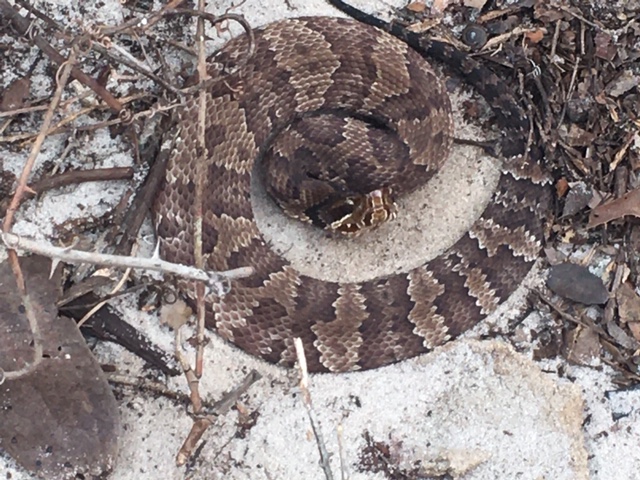
by Rick O'Connor | Nov 8, 2019
Over the last two years I have been surveying snakes in a local community on Perdido Key. The residents were concerned about the number of cottonmouths they were seeing and wanted some advice on how to handle the situation. Many are surprised by the number of cottonmouths living on barrier islands, we think of them as “swamp” residents. But they are here, along with several other species, some of which are venomous. Let’s look at some that have been reported over the years.
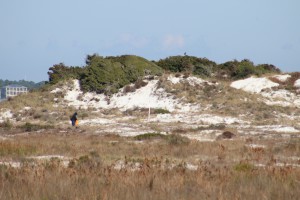
The dune fields of panhandle barrier islands are awesome – so reaching over 50 ft. in height. This one is near the Big Sabine hike (notice white PVC markers).
In the classic text Handbook of Reptiles and Amphibians of Florida; Part One – Snakes (published in 1981), Ray and Patricia Ashton mention nine species found on coastal dunes or marshes. They did not consider any of them common and listed the cottonmouth as rare – they seem to be more common today. In a more recent publication (Snakes of the Southeast, 2005) Whit Gibbons and Michael Dorcas echo what the Ashton’s published but did add a few more species, many of which I have found as well. Their list brings the total to 15 species. I have frequently seen four other species in Gulf Breeze and Big Lagoon State Park that neither publication included, but I will since they are close to the islands – this brings the total 19 species that residents could encounter.
Leading us off is the one most are concerned about – the Eastern Cottonmouth (Agkistrodon piscivorous). Though listed as “rare” by the Ashton’s, encounters on both Pensacola Beach and Perdido Key are becoming common. There is more than one subspecies of this snake – the eastern cottonmouth is the local one – and that the water moccasin and cottonmouth are one in the same snake. This snake can reach 74 inches in length (6ft). They are often confused with their cousin the copperhead (Agkistrodon contorix). Both begin life in a “copper” color phase and with a luminescent green-tipped tail. But at they grow, the cottonmouth becomes darker in color (sometimes becoming completely black) while the copperhead remains “copper”. The cottonmouth also has a “mask” across its eyes that the copperhead lacks. Believe it or not, the cottonmouth is not inclined to bite. When disturbed they will vibrate their tail, open their mouth showing the “cottonmouth” and displaying their fangs, and swiveling their head warning you to back off. Attacking, or chasing, rarely happens. I find them basking in the open in the mornings and seeking cover the rest of the day. Turning over boards (using a rake – do not use your hand) I find them coiled trying to hide. MOST of the ones I find are juveniles. These are opportunistic feeders – eating almost any animal but preferring fish. They hunt at night. Breeding takes place in spring and fall. The females give live birth in summer. As mentioned earlier, they seem to be becoming more common on our islands.
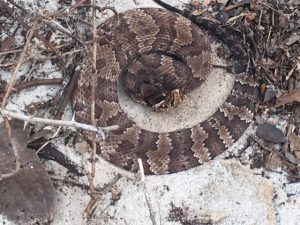
Eastern Cottonmouth with distinct “mask” and flattened body trying to intimidate.
Photo: Rick O’Connor
This year, while surveying for cottonmouths, I encountered numerous Eastern Coachwhips (Masticophis flagellum). These long slender snakes can reach lengths of 102” (8ft.), move very fast across the ground – often with their heads raised like a cobra – and, even though nonvenomous, will bite aggressively. They get their name from their coloration. They have a dark brown head and neck and a tan colored body – resemble an old coachwhip. They like dune environments and are excellent climbers. They consume lizards, small birds and mammals, and even other small snakes. They are most active during the daylight, but I usually find them beneath boards and other debris hiding. They have always been on the islands but encountered more often this past year. They lay eggs and do so in summer.
Their close cousin, the Southern Black Racer (Coluber constricta) is very similar but a beautiful dark black color. They can reach lengths of 70” (6ft.) and are also very fast. Like their cousin, they are nonvenomous but bite aggressively – often vibrating their tail like cottonmouths warning you to stay back. They are beneficial controlling amphibian, reptile, and mammalian animals. They are also summer egg layers.
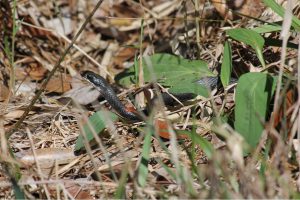
The southern black racer differs from otehr black snakes in its brillant white chin and thin sleek body.
Photo: Jacqui Berger.
There are a few freshwater snakes that, like the cottonmouth do not like saltwater, but could be found on the islands. These are in the genus Nerodia and are nonvenomous. There are two species (the Midland and Banded water snakes) that could be found here. They resemble cottonmouths in size and color and are often confused with them. They differ in that they have vertical dark stripes running across their jaws and have a round pupil. Though nonvenomous, they will bite aggressively. One member of the Nerodia group is the Gulf Coast Salt Marsh Snake (Nerodia clarkii clarkii). This snake does like saltwater and is found in the brackish salt marshes on the island. It is dark in color with four longitudinal stripes, two are yellow and two are a dull brown color. It only reaches a length of 36” (3ft.), is nocturnal, and feeds on estuarine fish and invertebrates.
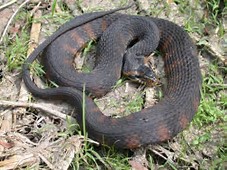
This banded water snake is often confused with the cottonmouth. This animal has the vertical stripes extending from the lower jaw, which is lacking in the cottonmouth.
Photo: University of Georgia
Other species that the guides mention, or I have seen, are the small Crowned Snake, Southern Hognose, Pine Snake, Pine Woods Snake, and the Rough Green Snake. I will mention here species I have seen in either Gulf Breeze or Big Lagoon State Park that COULD be found on the island: Eastern Coral Snake, Eastern Garter Snake, Pigmy Rattlesnake, Eastern Hognose, and the Corn Snake (also called the Red Rat Snake). Only two of these (Eastern Coral and Pigmy) are venomous.
Last, but not least, is the Eastern Diamondback Rattlesnake (Crotolus adamateus). This is the largest venomous snake in the United States, reaching 96” (8ft.). It is a diurnal hunter consuming primarily small mammals, though large ones can take rabbits. They prefer the dry areas of the island where cover is good. Palmettos, Pine trees, and along the edge of wetlands are their favorite haunts. Despite their preference for dry sandy environments, they – like all snakes – are good swimmers and large rattlesnakes have been seen swimming across Santa Rosa Sound and Big Lagoon. They tend to rattle before you get too close and you should yield to this animal. The have an impressive strike range, 33% of their body length, you should give these guys a wide berth. I have come across several that never rattled, I just happen to see them. Again, give them plenty of room when walking by.
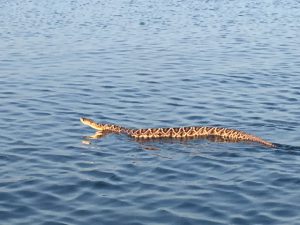
Eastern diamondback rattlesnake swimming in intracoastal waterway near Ft. McRee in Pensacola.
Photo: Sue Saffron
It is understandable that people are nervous about snakes being in popular vacation spots, but honestly… they really do not like to be around people. We are trouble for them and they know it. Most encounters are in the more natural areas of the islands. Staying on marked trails and open areas, where you can see them – and be sure to look down while walking, you should see them and avoid trouble. For more questions on local snakes, contact me at the county extension office.
References
Ashton, R.E., P.S. Ashton. 1981. Handbook of Reptiles and Amphibians of Florida; Part One – Snakes. Windward Publishing, Miami FL. Pp.176.
Gibbons, W., M. Dorcas. 2005. Snakes of the Southeast. University of Georgia Press, Athens GA. Pp. 253.
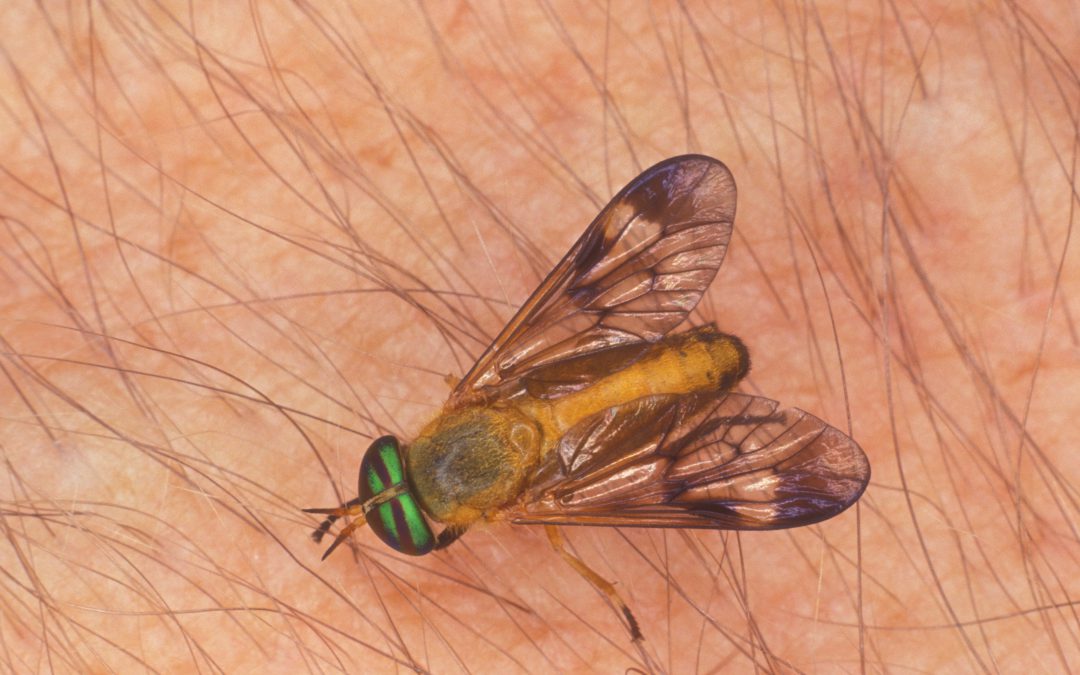
by Danielle S. Williams | Jun 7, 2019
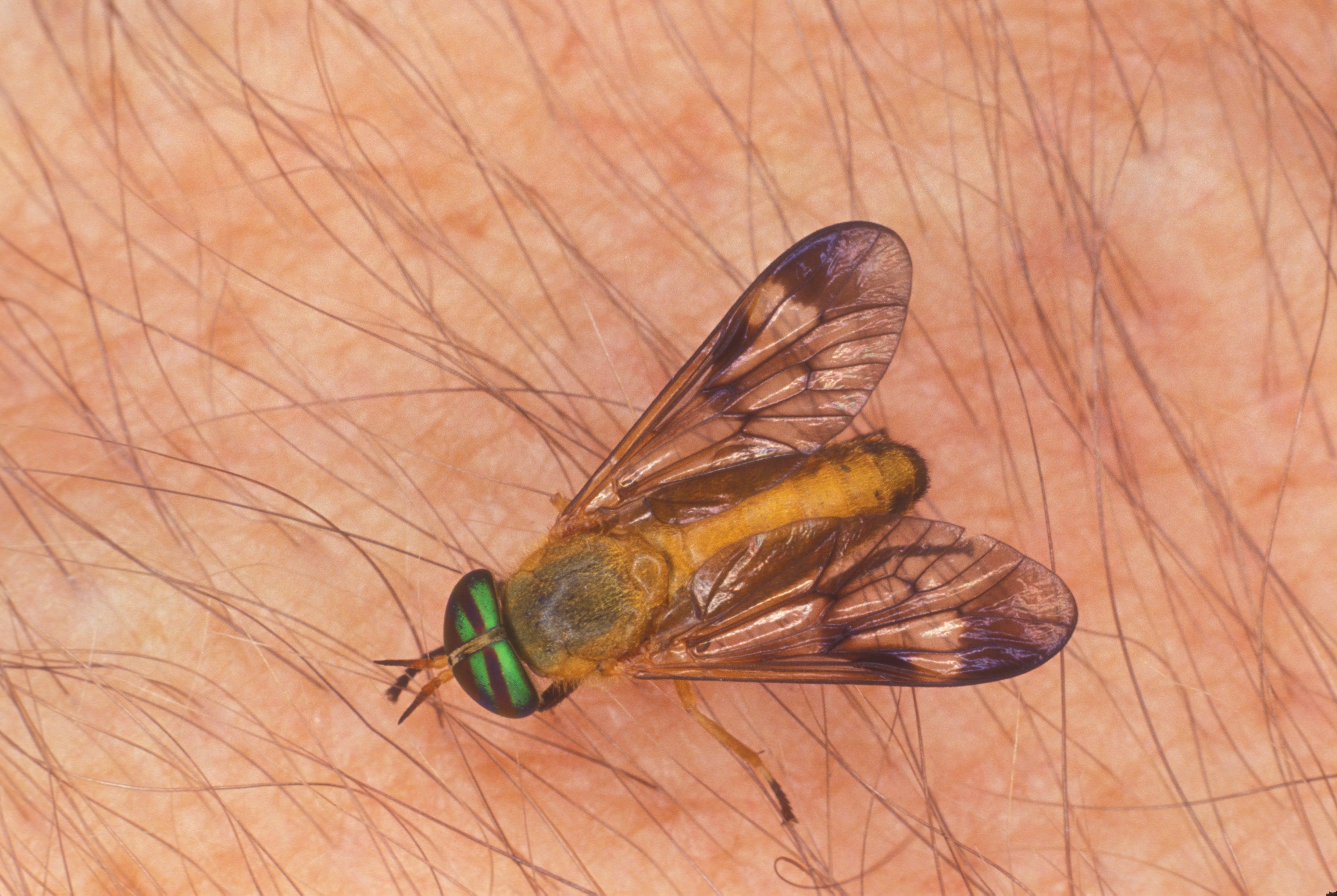
Adult yellow fly. Photo: James Castner
The summer heat is here and with that comes the misfortune of yellow flies, deer flies and horse flies. If you’ve ever experienced their painful bite, you know they can certainly make outdoor work and recreation miserable. These biting flies belong to the insect family Tabanidae and are widely recognized as being economically important pests of humans, cattle and horses. Their populations increase May through September and you’ll find them most active during the daylight hours.
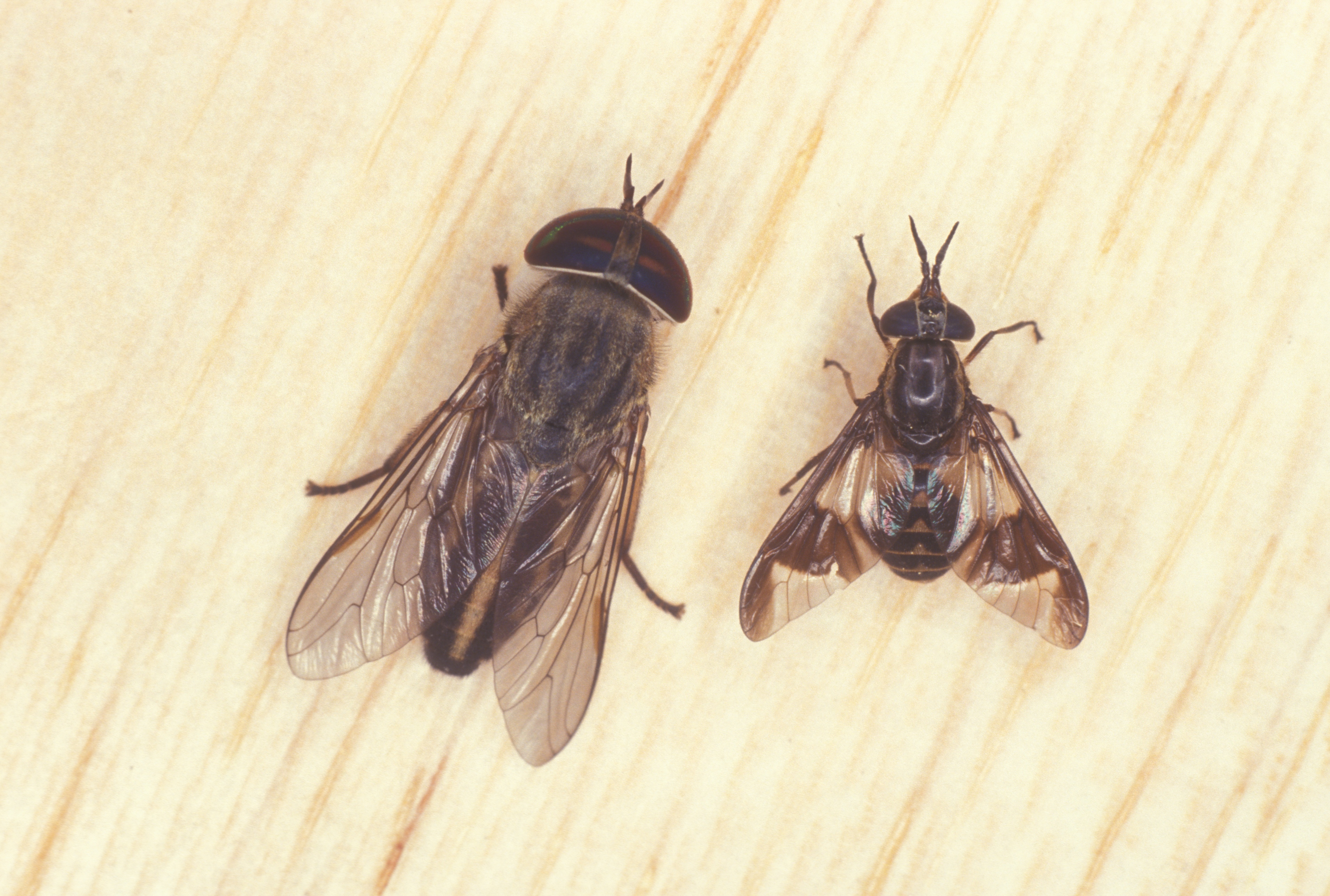
Horse fly (left) and deer fly (right). Photo: James Castner
Yellow flies and deer flies range in length from 1/3″ to 4/10″ and closely resemble each other. Deer flies are yellow to black, have stripes on the abdomen and have dark patches on their wings. Yellow flies have the same body shape, are yellowish but have dark purple-black eyes with florescent green lines. Horse flies are slightly larger, about 4/10″ to 1” with green or black eyes and black to dark brown in color.
Similar to mosquitoes, the female fly is responsible for inflicting a bite. The males feed primarily on pollen and nectar. Females are daytime feeders and use their large scissor-like mouthparts to lacerate skin for a blood meal. During feeding, anticoagulants in the female’s saliva are injected into the skin, which increases blood flow and in some cases can cause allergic reactions.
Standing water and mucky areas, such as ponds and swamps, serve as breeding grounds for most species of biting flies. They have an aquatic or semi-aquatic immature life cycle that requires adequate moisture for development. Females lay eggs in masses on plants, rocks, sticks, vegetation or any other objects found over water. Five to seven days after hatching, the larvae begin to feed on decaying organic matter. The mature larvae migrate to drier soil and develop into pupae. The pupal stage is a non-feeding stage that lasts about two to three weeks and concludes with the emerging adult.
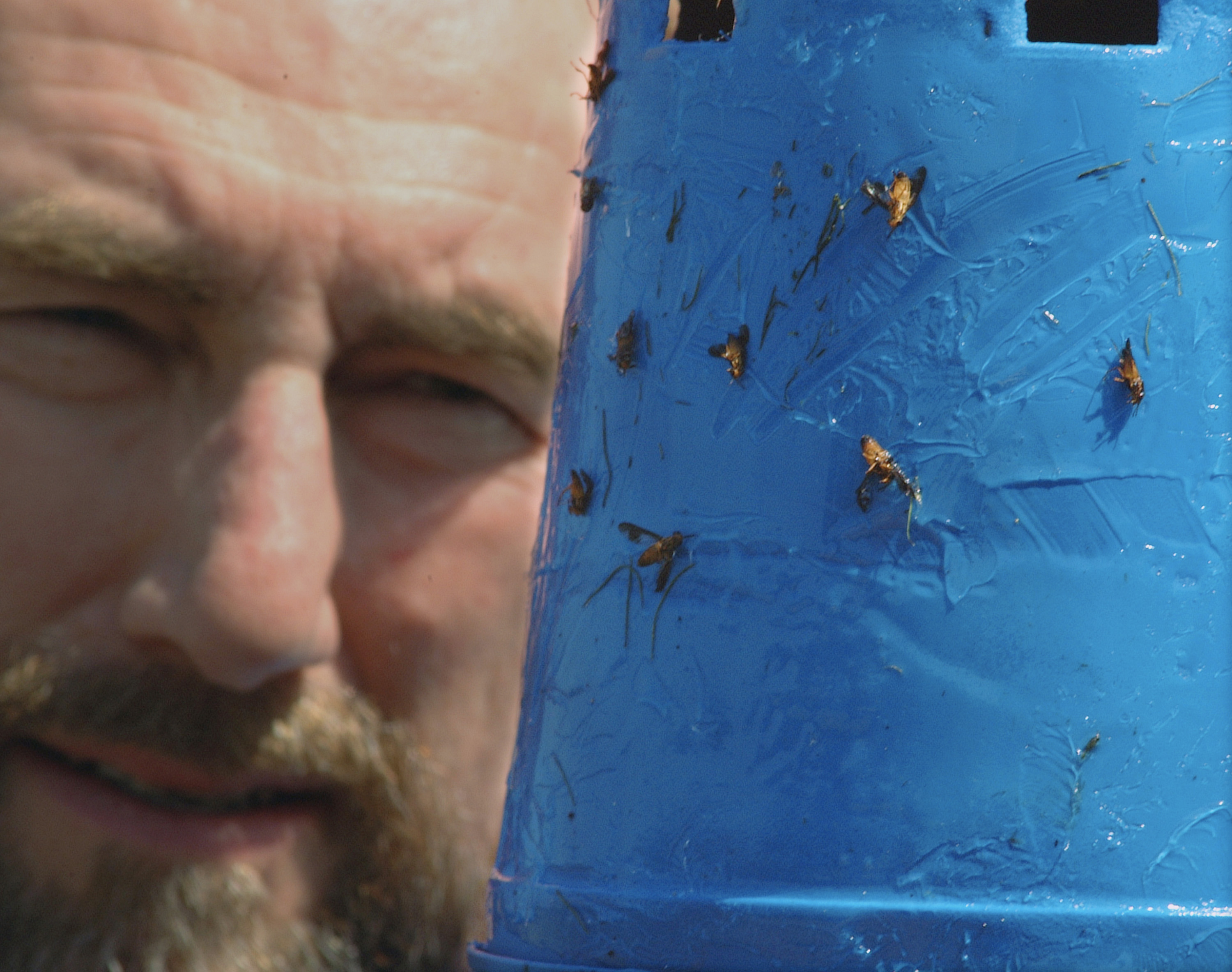
Trolling Deer Fly Trap developed by UF/IFAS Entomologist, Russ Mizell.
Unfortunately, controlling biting flies through source reduction and chemicals is difficult as they develop in natural areas where insecticide applications can be tricky. One method that can be effective in small-scale areas is the use of traps. Adults can be trapped using a big black ball or a blue plastic cup covered in glue. The traps should be hung about three to six feet above the ground and require wind movement for the attraction of flies.
The use of insect repellents can be helpful but not overly effective. A better prevention option is to wear protective clothing to reduce the likelihood of skin exposure to flies.
For more information on this topic, use the links to the following publications:
UF/IFAS Biting Flies
The Trolling Deer Fly Trap
The Yellow Fly Trap
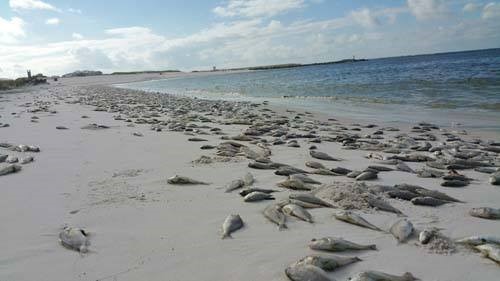
by Rick O'Connor | Sep 21, 2018
When I was in high school we were required to take a semester of communism during our senior year – the idea was to “know the enemy”. That is what we plan to do here… But, the enemy is a microscopic plant.
Its name is Karenia brevis. It is one of about 10 species of Karenia found in the ocean but it is the dominant form in the Gulf of Mexico. Karenia is referred to as “phytoplankton”, which suggests it is a microscopic plant. But in fact, it is in the Kingdom Protisita, not Plantae.
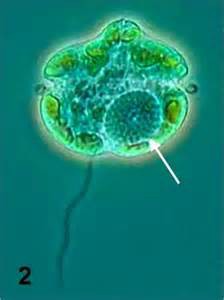
The dinoflagellate Karenia brevis.
Photo: Smithsonian Marine Station-Ft. Pierce FL
It is “plant-like” in that it has chlorophyll and can produce its own food. It differs in that it is a single cell. They are a type of phytoplankton called “dinoflagellates” because they have two flagella. The next question of course is what is flagella? It is a hair-like structure used by the cells for location. Though they can swim, they cannot out swim a current and so drift in the ocean – using their flagella to move up and down within the current and orient themselves.
The cell is covered with a protective shell called a theca, which as grooves, known as girdles, in which the flagella lie – one running east-west, the other north-south. They are between 18-45 microns long with the north-south flagella extending to look like a tail. They are members of the Gulf of Mexico community. Always out there, always have been. Typically, a plankton sample might find 1000 cells / liter. At these concentrations there does not seem to be a problem.
A problem?
What’s the problem?
The problem is that in its defense, K. brevis will release toxins. The toxin is a cocktail of lipophilic polyether compounds called brevotoxins. At low, or background concentrations, the levels of brevotoxins does not seem to effect marine organisms much at all. However, when the population of cells increases, to say 2 million / liter, fish kills can occur. The state of Florida will close shellfish harvesting if the concentrations reach 5000 / liter.
This brevotoxin is pretty strong stuff. It effects the nervous and immune systems, and effects the respiratory system. For marine vertebrates, it is deadly. At concentrations over 1,000,000 cells / liter, it can cause death for fish, dolphins, sea turtles, and manatees. Shellfish are filter feeders. During large blooms of K. brevis shellfish can consume enough to make humans very sick if they consume the shellfish.
So what causes their numbers to increase from 1000 to 1,000,000 cells / liter?
Summer…
Though K. brevis is not a plant, it is plant-like. Plants like sunlight and fertilizers. Warm shallow seas of southwest Florida are perfect. Nutrients are available in the environment and growth begins. Most blooms (large growth spurts) occur offshore. They love high salinities and not as common in our estuaries. However, they are plankton – wind and currents can move them closer to shore. During the raining season (summer) run-off from land brings with it nitrogen and phosphorus (nutrients) which can enhance a bloom. The fish kills begin, the respiratory problems for humans are annoying, and the tourist become concerned. Red tide can certainly have an impact on the local economy.
Globally, algal blooms seem to be increasing. Red tide can last a few days or a few months, each year varies. These are not exotic species; they are local Gulf residents who are finding warmer, saltier seas that they love. Algal blooms typically occur from September to February and though are common in southwest Florida, can extend across the Gulf to Texas – which the Florida panhandle is experiencing currently.
As Dr. Karl Havens mentions in his article attached, we cannot control the weather, but we can control the amount of nutrients we allow into our waterways. We should consider management practices that do just this to reduce the effects of these naturally occurring blooms.
Below are other articles from Sea Grant on this topic.
Frequently Asked Questions About the 2018 Red Tide Bloom – Betty Staugler, Florida Sea Grant
http://blogs.ifas.ufl.edu/charlotteco/2018/08/14/frequently-asked-questions-about-the-2018-red-tide-bloom/.
Understanding Florida’s Red Tide – Betty Staugler, Florida Sea Grant
https://www.flseagrant.org/news/2018/08/understanding-the-florida-red-tide/.
Watching and Waiting: Uncertainty About When the Algal Blooms Will End – Dr. Karl Haven, Florida Sea Grant
https://www.flseagrant.org/news/2018/07/watching-and-waiting-uncertainty-about-when-algae-blooms-will-end/.
REFERENCES
About Florida Red Tides. Florida Fish and Wildlife Conservation Commission. http://myfwc.com/research/redtide/general/about/.
Indian River Lagoon Species Inventory. Karenia brevis. Smithsonian Marine Station at Ft. Pierce. http://www.sms.si.edu/irlspec/Kareni_brevis.htm.
Pierce, R.H., M.S. Henry. 2008. Harmful Algal Toxins of the Florida Red Tide (Karenia brevis): natural chemical stressors in South Florida coastal ecosystems. Ecotoxicology. 17(7). Pp. 623-631. http://www.sms.si.edu/irlspec/Kareni_brevis.htm.



















